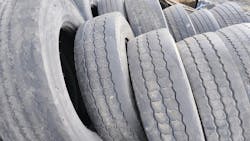Conspiracies and doomsday predictions aside, the importance of environmental stewardship should be evident by now. Pollution in any form does not make life better or the planet healthier.
Almost everything has a carbon footprint or some effect on the environment; clean air and water are not guaranteed. The goal should be to minimize that impact as much as possible. All major truck tire manufacturers have initiated sustainability practices with targets to further environmental stewardship.
The beginning of the truck tire life cycle is on the path to greater sustainability, but after the tire leaves the factory, the same level of attention is desperately needed. Retreading is the most apparent solution for additional tread life since it requires a fraction of the energy and raw materials needed to manufacture a new truck tire. Properly maintained Tier 1 and 2 tires will deliver multiple retreads to deliver the lowest possible cost per mile with negligible environmental impact.
Many offshore Tier 3 and 4 truck tires are not considered good candidates for retreading, so their life cycle is shorter. This means the sustainability factor is relatively low because most of the carbon footprint for a truck tire is centered on the manufacturing process. There are different environmental standards in places around the world.
In too many cases, pollution is considered a cost of doing business when foreign governments put economics before environmental concerns. Given those facts and more, the “one and done” truck tires are the least sustainable, with lower tread mileage compounding the negative impact.
Every tire must be removed from service when it eventually reaches the end of its useful life, otherwise known as an end-of-life, or ELT, tire. Decades ago, these tires were buried in landfills or illegally dumped in remote areas.
State and local governments started licensing the businesses that pick up and dispose of scrap tires with positive results. However, according to the Tire Recycling Foundation, 944 million illegal tires still need to be cleaned up, and 56 million stockpiled scrap tires need recycling. Compared to previous years, that is a remarkable improvement.
TRF estimates that approximately 71% of ELTs were beneficially used in 2021, with 28% recycled into new products. Considering there were 5 million tons of ELTs generated in 2021, that still leaves about 1.5 million tons of tires that were probably buried in landfills or dumped.
See also: Rohlwing: On tire tariffs, tiers, and Thailand
Solving the ELT problem requires creating markets for recycled rubber products. Floor mats, athletic playing surfaces, and automotive components are good examples of products derived from ELTs. However, there is not enough demand to close the gap in those markets.
I believe a logical solution to the ELT problem is rubber-modified asphalt, or RMA. Research has shown that pavement life can be extended with less rutting and fatigue cracking by mixing ground rubber with asphalt. More importantly, it has demonstrated more resistance to low-temperature cracking, which leads to potholes and related pavement damage.
Combine noise reduction with a smoother ride and better skid resistance to reduce traffic accidents in wet weather, and there is a lot to gain with the use of RMA.
RMA has existed since the 1960s and has been the subject of hundreds of scientific reports and studies that have gauged its effectiveness. Data has shown that a stiffer, smoother surface reduces tire wear, rolling resistance, and fuel consumption. There is no shortage of information on RMA's economic, operational, and environmental advantages as a road surface.
If RMA is adopted on a large scale, the results will be a sustainable market for ELTs and better roads. The trucking industry uses a lot of tires and travels more miles than any other ground transportation segment in North America. Trucks also create tons of ELTs that must be managed better.
While there are not enough markets for rubber mats to make a difference, there are more than 4 million miles of navigable roadways that could be home to millions of scrap truck tires. It’s a great idea that solves two problems but needs industry support to become a reality.
TRF is a joint effort of industry organizations and stakeholders to “incentivize market development and advance federal and state regulations,” so recycled rubber products like RMA can help solve the ELT problem and improve sustainability in the tire and transportation industries.
About the Author
Kevin Rohlwing
Kevin Rohlwing is the SVP of training for the Tire Industry Association. He has more than 40 years of experience in the tire industry and has created programs to help train more than 180,000 technicians.
